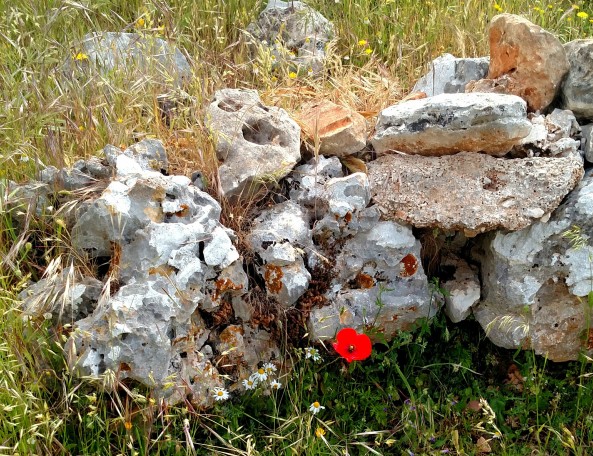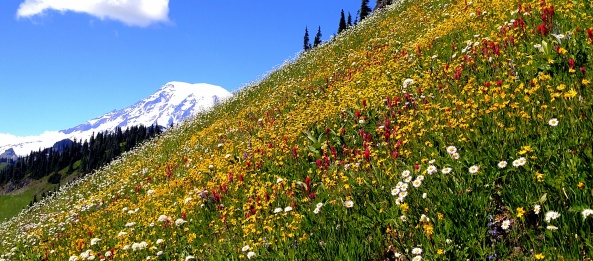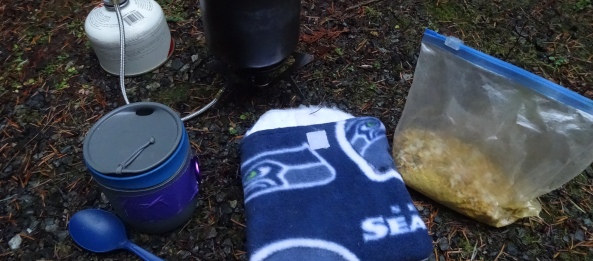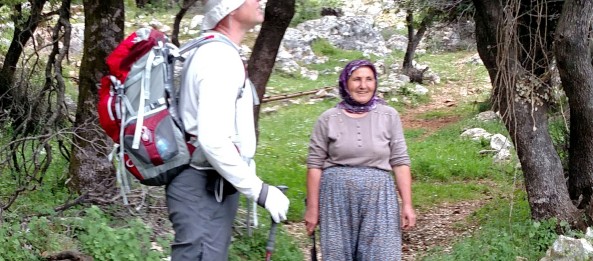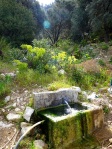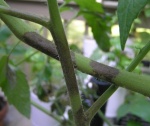Chunks of rough rock far outnumbered actual soil on these dry scrub-covered hills overlooking the Mediterranean on the steep narrow join of the Taurus Mountains to the sea. This section of the Lycian Way between Patara and Demre wound high above the sea, intersecting remote tumble-down ruins of ancient Lycian sarcophagi and Byzantine churches wrapped in the elegant red of Strawberry trees, a local variety of madrone. 
As we crested the juniper-covered hilltop, maneuvering around boulders and clumps of vivid Euphorbia, the outlines of a compound of several open-sided shacks draped in plastic emerged from the peek-a-boo fog, filled with the flotsam of temporary living. Two big cream colored dogs rose and shook, seemingly obligated to make some pretense of guarding but too lethargic to take it all the way. It was only after passing by that the pealing of dozens of small bells and the nearly child-like screams of goats reached us from somewhere in the murk. BLEHHH!!! BAAAAH! AAARRHHH! NAHHH! URRHHHHH!
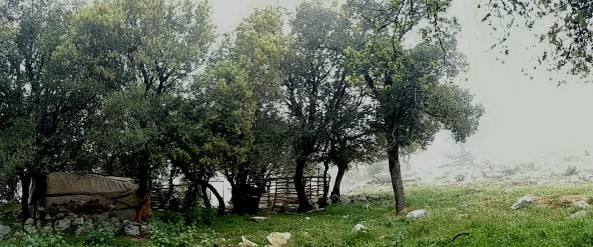
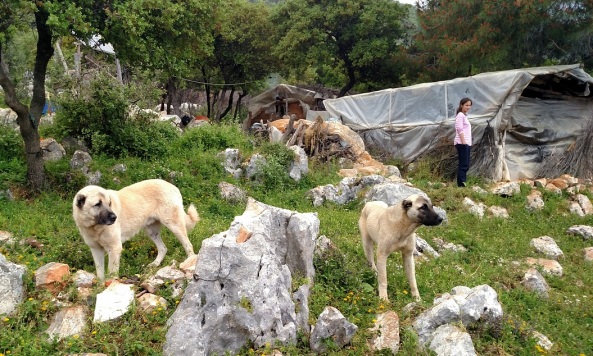
Then, suddenly there they were, tumbling down the hill from among the trees – black goats, white goats, brown goats, spotted goats, horned and bearded goats, babies leaping and everyone pushing and shoving for a prime spot on the narrow path where they could get a look at us. If we walked forward on the path, the goats would jostle for position to follow us. If we turned to look at them they’d stop short, beady goat-eyes staring and beards quivering. Few creatures do curiosity better than a goat.
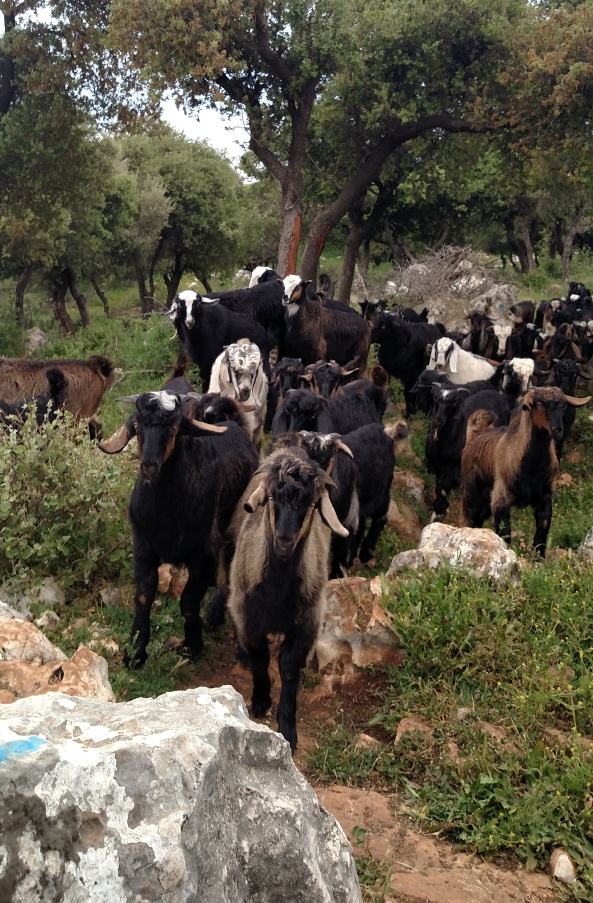
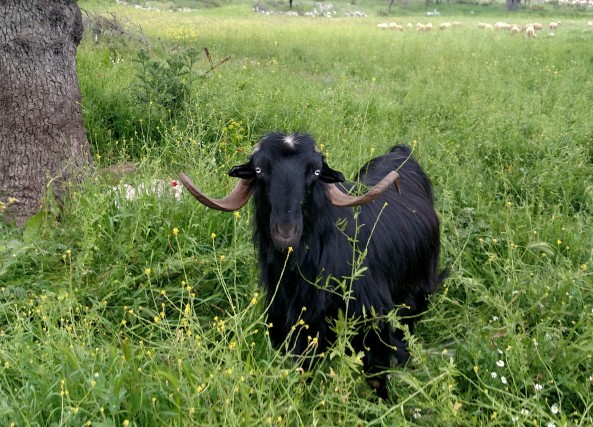
Coming down the hill behind the herd was a goat herder, a compact and vigorous looking woman of uncertain age in a headscarf, long-sleeved blouse pushed up on her arms, blousy pants gathered in at the ankle in the typical Lycian village style. Her face was creased with a cautious smile, and she carried a big curved machete in her hand. The two big Anatolian shepherd dogs followed close behind her.
She was a Yörük, of the nomadic people thought to be among the oldest surviving inhabitants of the Taurus Mountains and the last example of a traditional way of life that once dominated Anatolian culture. They were among the Turkic tribes that spread into the high plains and southern mountains of Anatolia from central Asia in the early eleventh century and blended with the indigenous nomadic pastoral peoples of the coast. For hundreds of years, at the beginning of every summer extended families of Yörük people have made the long trek from the steamy lowlands to pasture their goats, sheep and horses in the cool prairies and grassy highlands of the Taurus Mountains carrying all the bundles of their daily existence. They set up their temporary dwellings high up in the mountains, only returning to the coastal villages in the autumn before the first snows. Each family has their own territory, and a single family can move their flock over hundreds of miles over the course of a grazing season. It’s a culture where the women and girls are strong and equal because the life is hard and physical and requires all hands. There are no burkhas or segregation of the sexes here. In fact, we seldom saw men or children in these remote camps – only a few hardy women and their trusty, distinctive dogs.
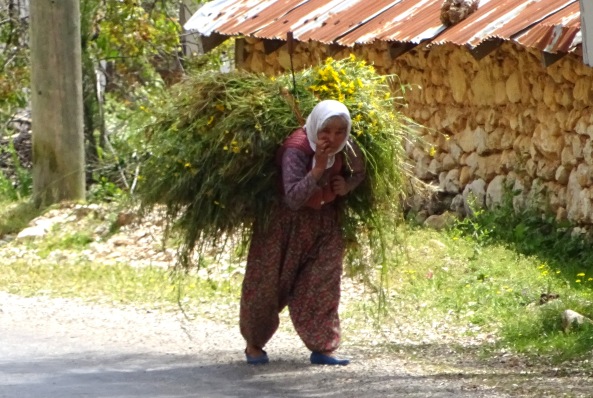
Woman carrying a big load of some sort of herb or grass home from the fields
The Yörüks of Anatolia resisted intense pressure through the 17th and 18th centuries from the Ottoman Empire to settle them (in order to collect taxes), only to succumb in large measure to a huge settlement program in the late 1970s and early 80s in which nomads were given land to encourage them to settle permanently. In the space of a single generation, the vast majority of Yörüks now live and work in the towns and only visit their ancestral highland areas for a picnic or family holiday. We had passed quite a few of these people going about their business in the villages and towns along the Lycian way. The mayor of Beymelek village, who hosted our group at his home one night, paid tribute to his nomad heritage with an arch of woven branches at his entryway in the style of the temporary structures that his family once built in the high hills during the summer grazing time.

Traditional woven-branch nomad arch, at the entryway of the home of the mayor of Beymelek
The pride and richness of the Yörük tribes of southern Anatolia was on full display at a nomadic culture festival that came upon us unexpectedly in Demre (ancient Myra) the day before. We had spent the morning taking in the stunning wall frescoes in the 5th century Church of St Nicholas, a necropolis of Lycian cave tombs from the 12th century BC, and a first-century AD Roman amphitheatre. Catching a little lunch of kofte and Gözleme at a café on one of the main streets, suddenly a bustle of music and color burst onto the sidewalk alongside us. Several of the nomadic tribes of the region had gathered to connect with their fellows and celebrate their local music, crafts and heritage. Every tribe had its own bright colored traditional costume, musical instruments, beribboned donkeys and camels, and big smiles telegraphing their pride. In just a few minutes they were past like an apparition.
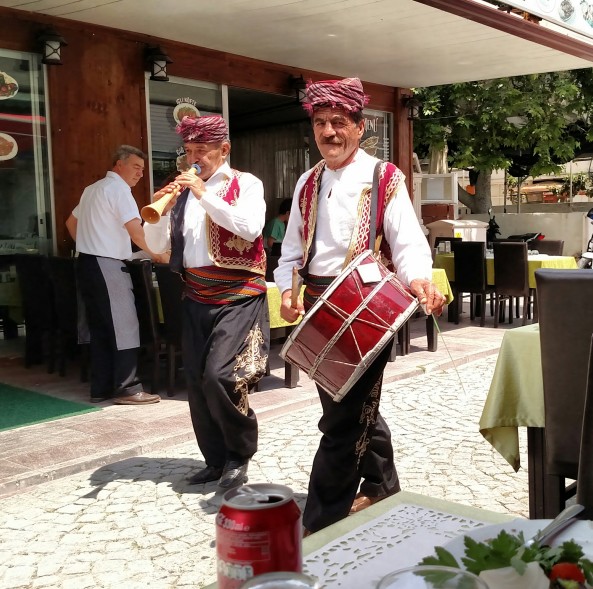
Proud nomad tribesmen at a festival in Myra

Nomad women in traditional dress
A few days later our trekking route had taken us into a remote rocky valley where we camped under the one remaing arched wall still standing from the sixth-century Alakalise church. Up the valley from the ruin, a pair of Yörük women had set up a large compound including plastic-draped structures and a large pen made of sticks and wire. As the night fell, the women and their dogs brought in their herd of at least 50 goats and kids from the surrounding rocky pasture to secure them in the pens. The bleating of the animals generated a cacophony of sound that ricocheted between the valley walls and down past our tents. The women made quick work of milking the nanny goats, gently pushing away the young ones. As they finished the milking, the animals suddenly quieted as if a magic wand had been waved over the herd. By the time we had awakened and broken camp the next morning, the women and dogs and goats had left their camp and vanished off into the day’s pastures.
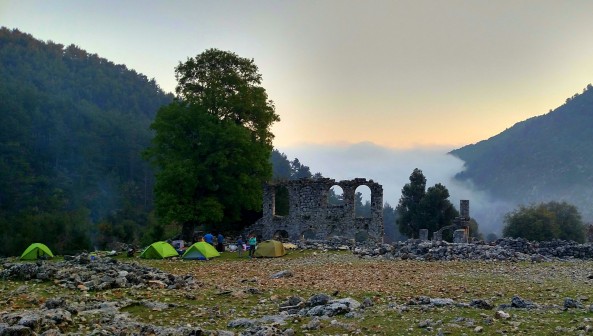
Sunset at Ala Kilise camp
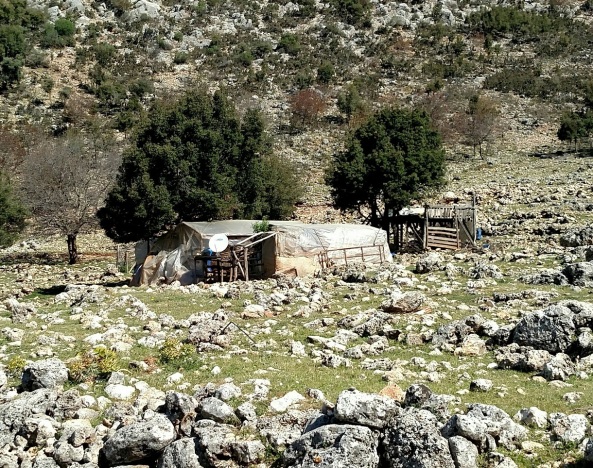
Nomad goat herding camp, Ala Kilise

Goats penned for milking at Ala Kilise – quite a racket!
So now we found ourselves on a foggy hilltop jostled by a crowd of curious goats and approached by a small but self-contained nomad woman with a large machete. Our Turkish guide approached her and she answered his questions quietly and with a shy smile toward the rest of our group. It turns out that she used the machete to cut down tree branches for the kids to eat, because years of grazing had left the lower canopy too high up in the air for the babies to reach. Somehow the woman, her quiet competence, the machete, the setting made for a fitting allegory of the strength and uniqueness of her culture. Long may they remain in these rocky hills.
